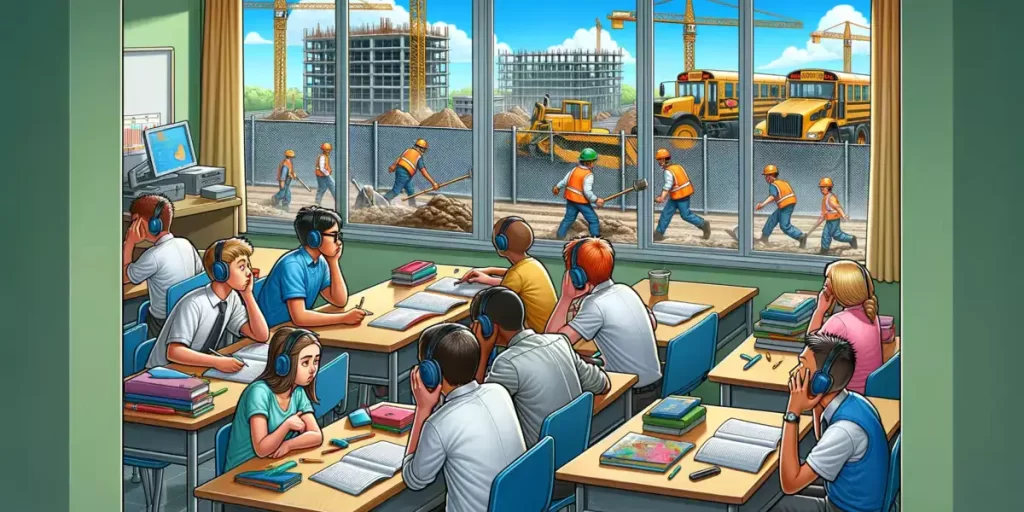Starting a conversation about classroom communication is like opening the door to a world filled with diverse voices and unique minds. Inside this world, teachers and students come together, each bringing their own stories, experiences, and ways of understanding. However, just like in any bustling and lively place, sometimes these voices struggle to be heard, and messages get lost in the noise.
Contents
- 1 What is Classroom Communication
- 2 Factors Affecting Classroom Communication
- 2.1 Teacher-Student Relationship
- 2.2 Classroom Environment
- 2.3 Language and Vocabulary
- 2.4 Cultural Differences
- 2.5 Teacher’s Communication Skills
- 2.6 Student Engagement and Participation
- 2.7 Technological Tools and Aids
- 2.8 Psychological Barriers
- 2.9 Physical Barriers
- 2.10 Instructional Methods and Materials
- 2.11 Health-Related Barriers
- 3 Learning Barriers in the Classroom
- 4 Overcoming Classroom Communication Barriers
- 5 Conclusion
What is Classroom Communication
Factors Affecting Classroom Communication
Several factors can affect how communication unfolds in the classroom, impacting the clarity, efficiency, and overall success of the learning experience. Here are some key factors:
Teacher-Student Relationship
The rapport between teachers and students can significantly influence communication. A positive, respectful relationship encourages open dialogue and makes students more receptive to instruction.
Classroom Environment
Both the physical setup (such as seating arrangements and acoustics) and the psychological atmosphere (such as a sense of safety and belonging) affect communication. An environment that promotes engagement and participation facilitates better communication.
Language and Vocabulary
The language used by the teacher and the students, including the complexity of vocabulary and sentence structure, can either enhance or hinder understanding. Ensuring language is appropriate for the student’s age and proficiency level is crucial.
Cultural Differences
Cultural backgrounds can influence communication styles, non-verbal cues, and perceptions. Awareness and sensitivity to cultural diversity in the classroom are essential for effective communication.
Teacher’s Communication Skills
A teacher’s ability to convey ideas, listen actively, and adapt their communication style to meet the needs of their students is crucial for effective classroom communication.

Student Engagement and Participation
Students’ willingness to participate, ask questions, and engage in discussions greatly affects the dynamic of classroom communication. Strategies to enhance engagement are vital.
Technological Tools and Aids
The use of educational technology, from simple audio-visual aids to sophisticated digital platforms, can greatly enhance or, if used improperly, hinder communication and understanding.
Psychological Barriers
Anxiety, fear of negative evaluation, and lack of confidence can prevent students from engaging in communication. Teachers need to create a supportive environment that encourages all students to participate.
Physical Barriers
Hearing difficulties, speech impairments, and other physical challenges can affect communication. Accommodations, such as assistive technology and adapted materials, can help overcome these barriers.
Instructional Methods and Materials
The choice of teaching methods (lectures, group work, interactive sessions) and materials (textbooks, handouts, multimedia presentations) can influence the effectiveness of communication. Varied approaches can address the diverse learning styles and needs of students.
Health-Related Barriers
Chronic health issues and factors like fatigue or poor nutrition can impact a student’s ability to concentrate and participate in learning
Addressing these factors effectively requires a multifaceted approach, including professional development for teachers, thoughtful classroom design, and the implementation of inclusive teaching strategies. Recognizing and adapting to the specific communication needs of a classroom can lead to a more productive and supportive learning environment.
Learning Barriers in the Classroom
Learning barriers in the classroom are obstacles that prevent students from fully engaging with the material and achieving their academic potential. These barriers can be diverse, affecting students in different ways depending on their circumstances, learning styles, and the classroom environment itself. Here are some common learning barriers in the classroom:
Cognitive Barriers
Difficulties with memory, attention, and problem-solving skills can hinder a student’s ability to absorb and process information effectively.
Physical Barriers
Disabilities or health issues, such as hearing or vision impairments, mobility challenges, or chronic illnesses, can limit a student’s ability to participate in certain activities or require specific accommodations.
Emotional and Behavioral Barriers
Anxiety, depression, low self-esteem, and behavioral disorders can impact motivation, engagement, and the ability to focus in the classroom.
Socioeconomic Barriers
Students from lower socioeconomic backgrounds may face challenges such as limited access to educational resources, lack of stable housing, or the need to work outside of school hours, all of which can affect their ability to concentrate on their studies.
Cultural and Linguistic Barriers
Students for whom the language of instruction is not their first language, or who come from cultural backgrounds significantly different from the school’s dominant culture, may struggle with communication, understanding, and cultural integration.
Educational Background
Gaps in foundational knowledge due to previous educational experiences can make it difficult for students to keep up with new material.
Motivational Barriers
Lack of interest in the subject matter, low self-efficacy beliefs (doubting one’s abilities), and external distractions can reduce students’ motivation to learn.
Environmental Barriers
Classroom conditions, such as overcrowding, inadequate facilities, noise, and poor lighting, can detract from the learning experience.
Teaching Methods
Instructional strategies that do not accommodate diverse learning styles or fail to engage students can be a significant barrier to learning.
Technology Access
In today’s increasingly digital learning environment, lack of access to technology or insufficient digital literacy skills can hinder a student’s ability to participate in learning activities.

Overcoming Classroom Communication Barriers
Strategies to Promote Effective Communication
To overcome these barriers and promote effective communication, teachers need to adopt various strategies. This includes creating an inclusive learning environment, using a common language, and being aware of non-verbal cues like body language.
Emphasizing Active Learning and Student Engagement
Encouraging active learning and ensuring student engagement are vital for effective classroom communication. Teachers should foster an environment where students feel comfortable sharing new ideas and participating in discussions.
Addressing Physical and Psychological Barriers
Overcoming physical and psychological barriers requires a variety of approaches. For instance, rearranging the classroom to accommodate students with disabilities or addressing psychological barriers through counseling and support can help students communicate more effectively.
Utilizing Visual Aids and Technology
Visual aids like charts, diagrams, and technological tools can significantly enhance communication, especially for students who may have difficulty with traditional verbal instruction. These tools can also help students who are visual or auditory learners.
Enhancing Teacher and Student Proficiency
Improving both teacher and student proficiency in communication is also important. This can involve training for teachers on inclusive practices and language proficiency enhancement for students.
Conclusion
Communication barriers can significantly impact the learning experience and student achievement. By understanding these common barriers and implementing strategies to overcome them, teachers can create a more effective and inclusive learning environment. This not only helps students understand and convey their thoughts better but also ensures they can communicate and engage actively, ultimately leading to academic success.
Boko Ducky has over 10 years of experience in helping individuals and organizations improve their communication skills.



